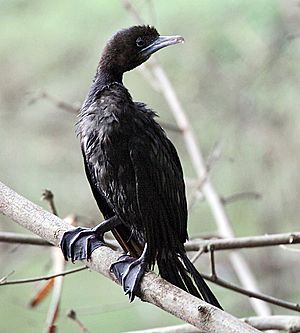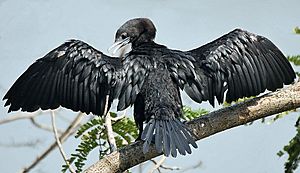Little cormorant facts for kids
The little cormorant (Microcarbo niger) is a type of cormorant, which are seabirds known for diving for fish. It's a bit smaller than the Indian cormorant and has a shorter beak without a pointy head. You can find these birds all over the Indian subcontinent and as far east as Java. In Java, people sometimes call it the Javanese cormorant.
Little cormorants usually look for food alone or in small groups. They like freshwater places like small ponds, big lakes, and streams. Sometimes, they even visit coastal areas where rivers meet the sea. Like other cormorants, you'll often see them sitting on a rock by the water, holding their wings out wide after a swim.
When it's breeding season, their whole body turns shiny black. But when they're not breeding, their feathers are brownish, and they have a small white patch on their throat. These birds like to nest together in trees, often with other waterbirds in large groups called heronries.
Contents
What Does the Little Cormorant Look Like?

The little cormorant is about 50 centimeters (20 inches) long. It's just a little bit smaller than the Indian cormorant. The Indian cormorant has a thinner, longer bill with a hooked tip, blue eyes, and a more pointed head.
When a little cormorant is an adult and ready to breed, its feathers are all shiny black. It might have a few white spots on its face and a short crest (a small tuft of feathers) on the back of its head. Its eyes and the skin around its face are dark.
When the bird is not breeding, or if it's a young bird, its feathers are brownish. Its bill and the skin around its throat might look more fleshy. The crest on its head isn't as noticeable, and you can sometimes see a small, clear white patch on its throat.
It's hard to tell male and female little cormorants apart just by looking at them. However, males are usually a bit bigger.
Where Do Little Cormorants Live?
You can find the little cormorant in many countries. These include India, Sri Lanka, Bangladesh, Pakistan, and parts of Nepal. They also live in Burma, Thailand, Laos, and Indonesia.
They don't live in the high Himalayas. However, some have been seen far from their usual homes, like in Ladakh. They prefer wet areas, from small ponds in villages to large lakes. Sometimes, they even visit places where the ocean tide comes in, like river mouths.
How Do Little Cormorants Behave?
Little cormorants usually look for food alone or in small, spread-out groups. They dive underwater to catch their food, which is mostly fish. One study in northern India found that these birds fished in water less than a meter deep. They caught fish that were about 2 to 8 centimeters (1 to 3 inches) long.
They use their webbed feet to push themselves through the water when swimming underwater. After catching a fish, they often bring it to the surface to swallow it. Other birds, like other cormorants, painted storks, gulls, and egrets, might try to steal their catch. Indian cormorants often fish together in bigger groups.
Like all cormorants, they come out of the water and hold their wings out wide for a while. People think they do this to dry their wings, but scientists still discuss this idea. A study in Sri Lanka showed that they always spread their wings after being underwater. The longer they were underwater, the longer they spread their wings. Also, they spent less time spreading their wings when the air was warmer and drier. This supports the idea that they are drying their wings.
Little Cormorant Life Cycle and Reproduction
The breeding season for little cormorants changes depending on where they live. In Pakistan and northern India, it's from July to September. In southern India, it's from November to February. In Sri Lanka, they breed from December to May, and in Bangladesh, from May to October.
Males try to attract a mate at the nest site. They flutter their wings while holding their head back and bill up. Then, they lower their bill. Once a pair forms, the male also brings food to the female as part of their courtship.
Both parents help build the nest. It's a platform made of sticks, usually placed in trees or sometimes even on coconut palms. They might nest next to Indian pond herons and little egrets in large colonies. Building the nest takes about two weeks.
The whitish eggs get muddy as they get older. The female starts sitting on the eggs as soon as the first one is laid. This means the eggs hatch at different times, so the chicks in one nest can be very different in age. A female can lay between two and six eggs, usually about two days apart. The eggs hatch after 15 to 21 days. The baby chicks are covered in soft downy feathers and have a bare red head. Young birds can leave the nest after about a month.
Little cormorants make sounds near their nests and where they sleep. They make low roaring sounds, grunts, groans, and calls like ah-ah-ah and kok-kok-kok. They often sleep together in large groups with other waterbirds.
Images for kids
See also
 In Spanish: Cormorán de Java para niños
In Spanish: Cormorán de Java para niños






